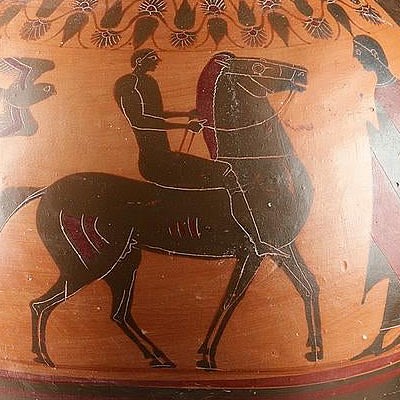Roman Basalt Carving of Goddess Victory
Lot 76
About Seller
Artemis Gallery
686 S Taylor Ave, Ste 106
Louisville, CO 80027
United States
Selling antiquities, ancient and ethnographic art online since 1993, Artemis Gallery specializes in Classical Antiquities (Egyptian, Greek, Roman, Near Eastern), Asian, Pre-Columbian, African / Tribal / Oceanographic art. Our extensive inventory includes pottery, stone, metal, wood, glass and textil...Read more
Estimate:
$8,000 - $12,000
Absentee vs Live bid
Two ways to bid:
- Leave a max absentee bid and the platform will bid on your behalf up to your maximum bid during the live auction.
- Bid live during the auction and your bids will be submitted real-time to the auctioneer.
Bid Increments
| Price | Bid Increment |
|---|---|
| $0 | $25 |
| $300 | $50 |
| $1,000 | $100 |
| $2,000 | $250 |
| $5,000 | $500 |
| $10,000 | $1,000 |
| $20,000 | $2,500 |
| $50,000 | $5,000 |
| $100,000 | $10,000 |
| $200,000 | $20,000 |
About Auction
By Artemis Gallery
Jun 4, 2020
Set Reminder
2020-06-04 10:00:00
2020-06-04 10:00:00
America/New_York
Bidsquare
Bidsquare : Exceptional Antiquities, Asian, Ethnographic
https://www.bidsquare.com/auctions/artemis-gallery/exceptional-antiquities-asian-ethnographic-5185
An important one-day auction featuring museum-worthy examples of Egyptian, Greek, Roman, Etruscan, Near Eastern, Far East / Asian, Pre-Columbian, African / Tribal, Oceanic, Native American, Spanish Colonial, Russian, Fossils, Ancient Jewelry, Fine Art, so much more! Artemis Gallery info@artemisgallery.com
An important one-day auction featuring museum-worthy examples of Egyptian, Greek, Roman, Etruscan, Near Eastern, Far East / Asian, Pre-Columbian, African / Tribal, Oceanic, Native American, Spanish Colonial, Russian, Fossils, Ancient Jewelry, Fine Art, so much more! Artemis Gallery info@artemisgallery.com
- Lot Description
Roman, Eastern Provinces the/ Levant, the Hauran (southern Syria / northern Jordan), ca. 2nd to 4th century BCE. A striking basalt carving of the goddess Victory (Nike), standing draped in dramatic clothing. Wings, their surfaces bubbled to create an impression of thick feathers, are just visible protruding from her back. Her stola is clearly sculpted, with thick folds carved in wide bands that flow down the body and a draped waist. Her stomach is highlighted with a teardrop-shaped form. Her remaining wrist is adorned with a bracelet. Below her waist, the folds of her garment draw inward, highlighting the shape of her hips and thighs. The basalt has weathered beautifully, and this is a rare non-marble example of Roman sculpture. Size: 10.75" L x 14.5" W x 25" H (27.3 cm x 36.8 cm x 63.5 cm); 26.75" H (67.9 cm) on included custom stand.
Similar basalt carving from the Roman period is known from throughout the Hauran. The region - which is largely a desert steppe punctuated by oases - includes the Lajat volcanic field. As a result, basalt is widely available and a unique and distinctive vernacular architecture grew in the region using the dark, porous stone. It is a fusion of Hellenistic, Nabatean, and Roman styles. Cities like Bosra, Qanawat, Shahba, and others contain Roman temples, theatres, and villas decorated with dark basalt carving like this statue.
See another example of Hauran basalt carving from the Roman period at the British Museum: https://www.britishmuseum.org/research/collection_online/collection_object_details.aspx?objectId=368111&partId=1&searchText=roman+basalt&images=on&page=1
Provenance: private East Coast, USA collection; ex-William Froelich collection, New York, USA, acquired in the 1970s
All items legal to buy/sell under U.S. Statute covering cultural patrimony Code 2600, CHAPTER 14, and are guaranteed to be as described or your money back.
A Certificate of Authenticity will accompany all winning bids.
We ship worldwide and handle all shipping in-house for your convenience.
#146300The torso is a fragment as shown, with extensive weathering and losses, including pitting on the surface commensurate with age to basalt and a large divot in the exposed shoulder.Condition
- Shipping Info
-
All shipping is handled in-house for your convenience. Your invoice from Artemis Gallery will include shipping calculation instructions. If in doubt, please inquire BEFORE bidding for estimated shipping costs for individual items.
-
- Buyer's Premium



 EUR
EUR CAD
CAD AUD
AUD GBP
GBP MXN
MXN HKD
HKD CNY
CNY MYR
MYR SEK
SEK SGD
SGD CHF
CHF THB
THB














